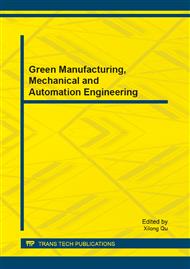[1]
Zhong, Y., L. Jin, and X. Chen (2012).
Google Scholar
[2]
Zhong, X. (2012) Blind channel estimation of relaying cooperative communication in Iota systems. International Review on Computers and Software 2(6): 450-455.
Google Scholar
[3]
Zhang, Z, et al (2012) Code division multiple access/pulse position modulation ultra-wideband radio frequency identification for Internet of Things: Concept and analysis. International Journal of Communication Systems 3(5): 1103-1121.
DOI: 10.1002/dac.2312
Google Scholar
[4]
Oteafy, S.M.A. and H.S. Hassanein (2012) Resource re-use in wireless sensor networks: Realizing a synergetic internet of things. Journal of Communications 4(4): 484-493.
DOI: 10.4304/jcm.7.7.484-493
Google Scholar
[5]
Thompson, C.W. and F. Hagstrom (2008) Modelling healthcare logistics in a virtual world. IEEE Internet Computing 5(6): 100-104.
DOI: 10.1109/mic.2008.106
Google Scholar
[6]
Yan, M. (2011) the design and application of intelligent electrical outlet for campus's electricity saving and emission reduction. Journal of Computers 6(8): 1696-1703.
Google Scholar
[7]
Wang, S. -D., X. -L, Wang and Y. Wang (2011) Research on EPC logistics information system base on RFID. Journal of Harbin Institute of Technology (New Series) 7(11): 130-134.
Google Scholar
[8]
Suh, K., T. Smith, and M. Linhoff (2012) Leveraging socially networked mobile ICT platforms for the last-mile delivery problem. Environmental Science and Technology 8(5): 9481-9490.
DOI: 10.1021/es301302k
Google Scholar
[9]
Pan, W. -T. And P. -W. Chen (2011) A study on the logistic service satisfaction for internet marketing enterprise using data mining technology. Advances in Information Sciences and Service Sciences 9(3): 114-120.
DOI: 10.4156/aiss.vol3.issue2.13
Google Scholar
[10]
Miao, J. and L. Wang (2012) Rapid identification authentication protocol for mobile nodes in internet of things with privacy protection. Journal of Networks 10(18): 1099-1105.
DOI: 10.4304/jnw.7.7.1099-1105
Google Scholar
[11]
Lvqing, Y (2012) Analysis and design of campus safety management system based on internet of things. Journal of Convergence Information Technology 11(15): 400-408.
DOI: 10.4156/jcit.vol7.issue15.47
Google Scholar
[12]
Kumdee, O., T. Bhongmakapat, and P. Ritthipravat (2011) Prediction of nasopharyngeal carcinoma recurrence by neuron-fuzzy techniques. Fuzzy Sets and Systems 12(6): 37-39.
DOI: 10.1016/j.fss.2012.03.004
Google Scholar
[13]
Karnouskos, S (2011) Asset monitoring in the service-oriented Internet of Things empowered smart grid. Service Oriented Computing and Applications, 13(3): 207-214.
DOI: 10.1007/s11761-012-0102-6
Google Scholar


